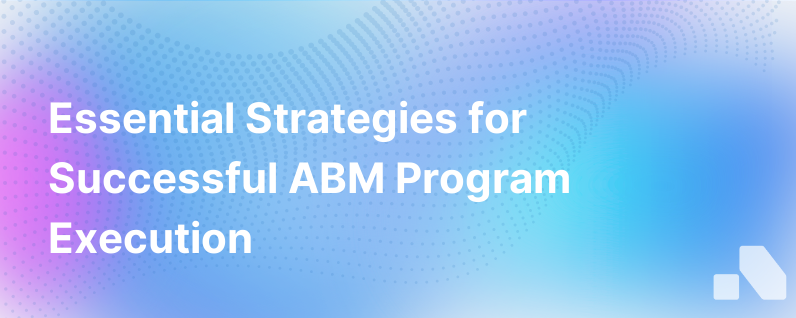5 Must Have Strategies For Creating A Successful Abm Program
Published on September 21, 2023 by Sawyer Middeleer
Account-Based Marketing (ABM) is a strategic approach to business marketing in which an organization considers and communicates with individual prospect or customer accounts as markets of one. ABM is especially useful for businesses that pursue specific high-value clients or operate in niche markets. Drawing on concentrated resources with a tailored message helps winning those lucrative accounts more efficiently and effectively than traditional broad-brush strategies.
However, success in ABM isn’t guaranteed just by shifting your approach. Here are five must-have strategies for creating a successful ABM program, brought together from the insights of marketers who’ve led their companies to high-stakes wins:
1. Start with High-Quality Data and Insight
A successful ABM strategy is built on a foundation of reliable data. Understanding which accounts to target and what resonates with them requires deep knowledge of:
- The industry landscape they operate in
- Their business challenges and pain points
- Internal decision-makers and influencers
- Current and potential engagement level
This is achievable by pooling together various data sources, such as CRM databases, social media interactions, transaction history, and third-party data providers. The use of advanced AI tools can further enhance this process by predicting the potential value of accounts and identifying those which are more likely to engage.
2. Deliver Personalized and Relevant Content
Personalization is a cornerstone of any ABM program. That's because personalized experiences capture attention and demonstrate that you understand an account's specific challenges and goals. For instance, instead of generic sales pitches, craft personalized communication that addresses specific business pain points and how your products or services provide the best-suited solutions.
Structuring content based on the customer journey for each account is also critical. By understanding the journey, you can deliver content that matches every stage of their decision-making process, from awareness and consideration to decision and advocacy.
3. Align Sales and Marketing Efforts
Alignment between sales and marketing is crucial to ABM success. Both teams should work in lockstep to define the ideal customer profile, identify target accounts, develop personalized outreach programs, and tailor the messaging.
Having a Service Level Agreement (SLA) can codify this alignment, defining roles, mutual goals, and specific metrics to measure. For instance, sales could agree to follow up on marketing qualified leads (MQLs) within a certain time frame, while marketing could commit to a specific number of MQLs each quarter.
4. Deploy Multi-Channel Engagement Strategies
In an ABM strategy, multi-channel outreach that caters to preferred communication channels maximizes your visibility and engagement opportunities. This could include:
- Direct outreach through email and phone calls
- Social media engagement on platforms like LinkedIn
- Customized events or webinars
- Direct mail for physical touchpoints
An effective ABM program should also incorporate a mix of both inbound and outbound strategies. Paid advertising, SEO, and content marketing can help attract accounts, while targeted email campaigns and sales development rep (SDR) activities take on a more proactive outreach role.
5. Measure and Optimize Your ABM Efforts
Continuous measurement against your objectives allows you to assess the health of your ABM program and its ROI. Common ABM metrics to track include account engagement score, pipeline velocity, win rates, average deal size, and revenue generated per account.
Additionally, it is important to capture qualitative feedback from both the target accounts and your sales team. This provides insights into the quality of engagement and the potential need to tweak the messaging or outreach tactics.
Implementing ABM with Tools like Aomni:
When deploying a successful ABM strategy, utilizing high-grade tools elevates efficiency and effectiveness. Systems like Aomni can streamline the ABM process by offering capabilities such as:
- Real-time account research and insights
- Actionable competitive analysis
- Personalization at scale for sales content
This particular AI-powered platform works in tandem with your strategies to provide the level of tailored information that forms the backbone of successful ABM initiatives. By identifying and focusing on high-value accounts, providing customized content and insights, and aligning sales and marketing teams, tools like Aomni can turn your ABM program into a dependable revenue driver.
Final Considerations
In conclusion, a successful ABM strategy should be data-driven, personalized, and aligned across organizational functions, leveraging multiple channels to reach and resonate with target accounts while continuously measuring and optimizing results.
Each of these strategies demands careful planning, execution, and analysis. However, the rewards of a meticulously crafted ABM program — heightened engagement, increased efficiency, larger deals, and stronger relationships with your most valuable customers — underscore the importance of getting it right.
Ultimately, by integrating these strategies with innovative platforms such as Aomni, businesses can create an ABM program that not only drives sales but also builds a solid foundation for long-term success in the B2B space.